Mississauga and Brampton – The Hurontario LRT
It is an interesting comparison that in Vancouver, 5.7 km of SkyTrain light-metro subway will cost over $3 billion and 16km of new SkyTrain light metro in Surrey and Langley will cost around $5 billion (both projects will actually cost over $11 billion for 21.7 km of new line, including the much needed rehab), while in Ontario 18 km of the Hurontario LRT will cost only $1.4 billion.
In Metro Vancouver, 21.7 km light-metro expansion will cost close to $507 million/km, while in Ontario 18 km of LRT will cost around $78 million/km.
Put another way, one could build 6.5 times more per km building with LRT than with light metro. Instead of 21.7 km of SkyTrain, one would get 141 km or more of new line, for $11 billion, building with LRT!
First tracks to be laid on major section of $1.4-billion Mississauga-Brampton transit line
Published August 25, 2022
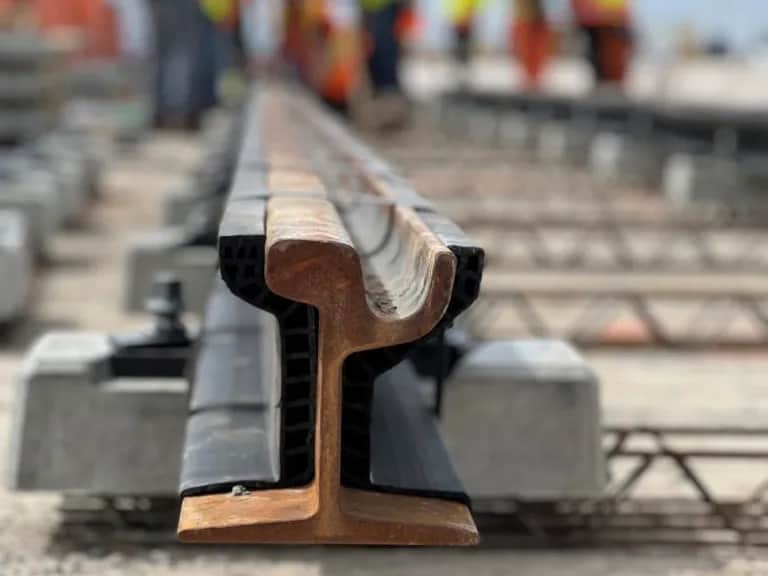
Starting this Sunday (Aug. 28), drivers on Hurontario St. in Mississauga and Brampton will be faced with a series of rolling partial intersection closures as the first tracks on the main section of a $1.4-billion light rail transit (LRT) route will be laid.
The tracks “will be laid along the centre of Hurontario St., where construction will occur at every other intersection to allow for detours,” officials with Metrolinx, the provincial agency overseeing the huge Hazel McCallion LRT project, said in a news release today (Aug. 25). “This is a key sign of progress for the 18-kilometre rapid transit line.”
Project leaders note that while the first tracks were actually laid earlier this year at the route’s Operations, Maintenance and Storage Facility on the Mississauga-Brampton border, “…this is the first track installation along the LRT guideway where the light rail vehicles will run on Hurontario St.”
The ongoing partial intersection closures will restrict drivers from turning left in both directions while driving along Hurontario St.
“With this approach, the track installations can occur quickly and more efficiently with less impact overall,” Metrolinx officials say. “Once the track is laid, the intersections will reopen with no more than two consecutive intersections being closed at the same time.”
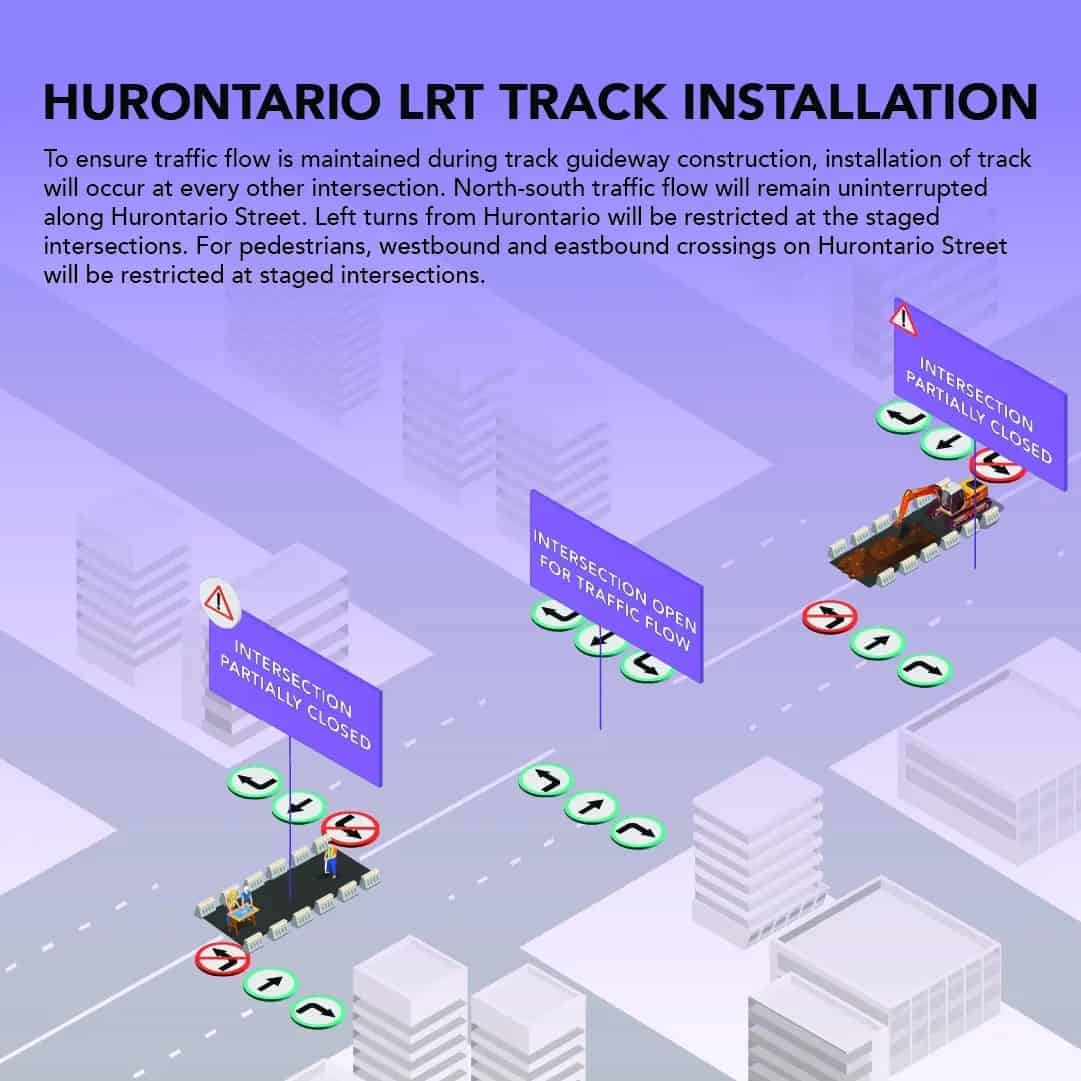
(Image: Metrolinx)
Work begins on Aug. 28 at the intersection of Hurontario St. and Milverton Dr./Watline Ave. (just north of Matheson Blvd.) and will continue until Sept. 16.
Additionally, project leaders say, the Hurontario St. and Sandstone Dr./Brunel Rd. intersection (just south of Britannia Rd.) will be partially closed from Sept. 6 until Sept. 28.
Metrolinx says work at both intersections is expected to be completed by October.
Track installation will also be ongoing on Hurontario St. at Aldridge St./Traders Blvd. and Matheson Blvd.
Recent work on the 18-kilometre Hazel McCallion LRT, which is to be completed by fall 2024, has also focused on a section of 100-year-old Mary Fix Creek near Port Credit GO station in south Mississauga.
Port Credit GO is the starting point of the LRT route, which when up and running will make 19 stops between south Mississauga and Brampton. It will connect to major transit systems including GO Transit (Milton and Lakeshore West Lines), the Mississauga Transitway, Brampton Transit, ZUM and MiWay.
Meanwhile, City of Mississauga officials are still aggressively pushing for reinstatement of initial plans to create an “LRT loop” that would more directly and conveniently serve condo residents and office workers in the city’s downtown core around Square One.
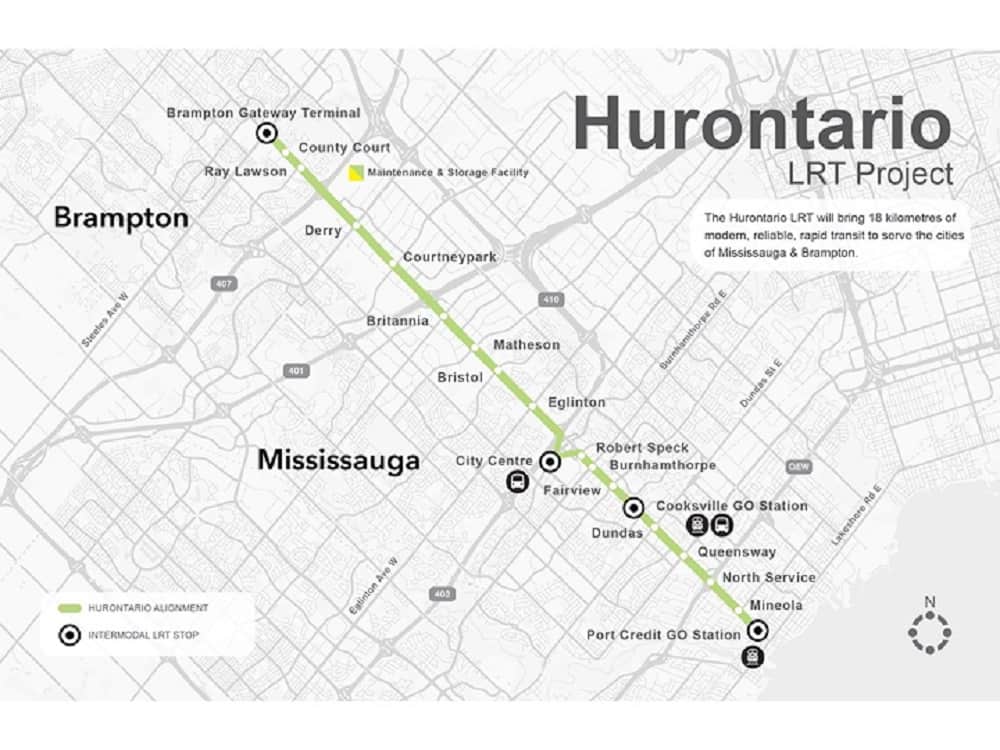
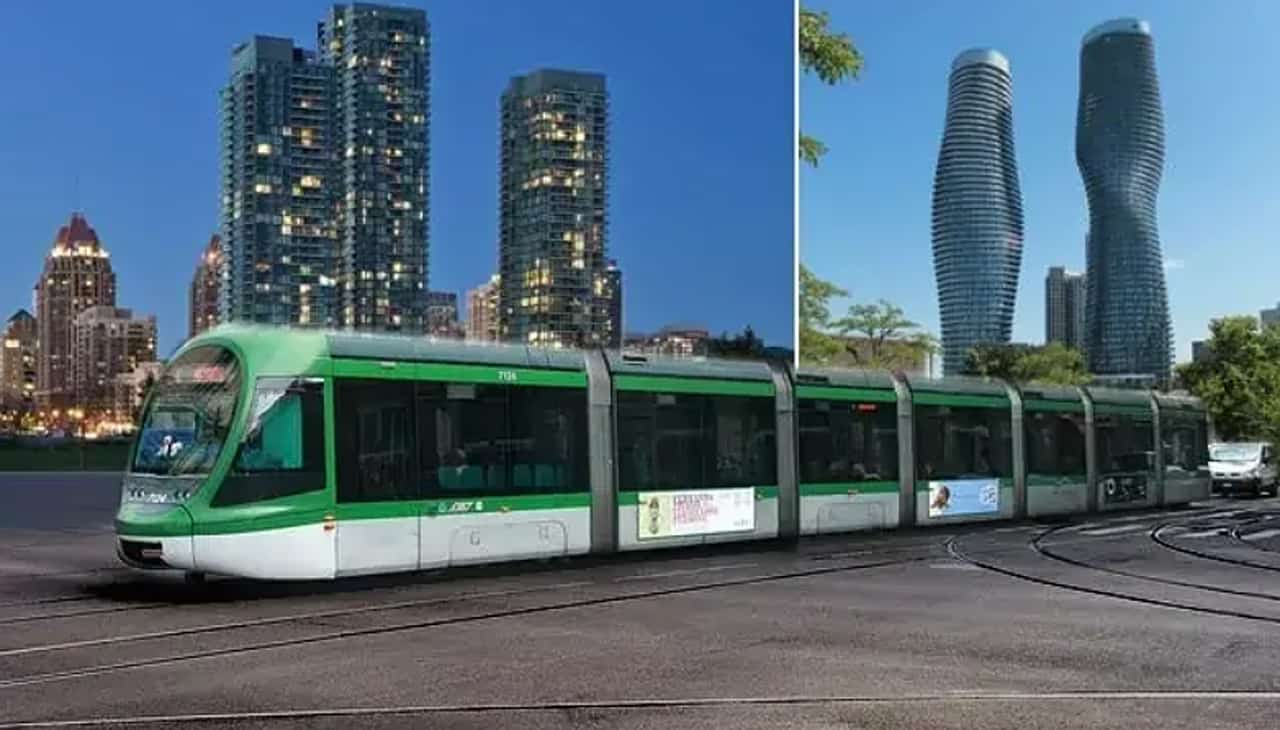
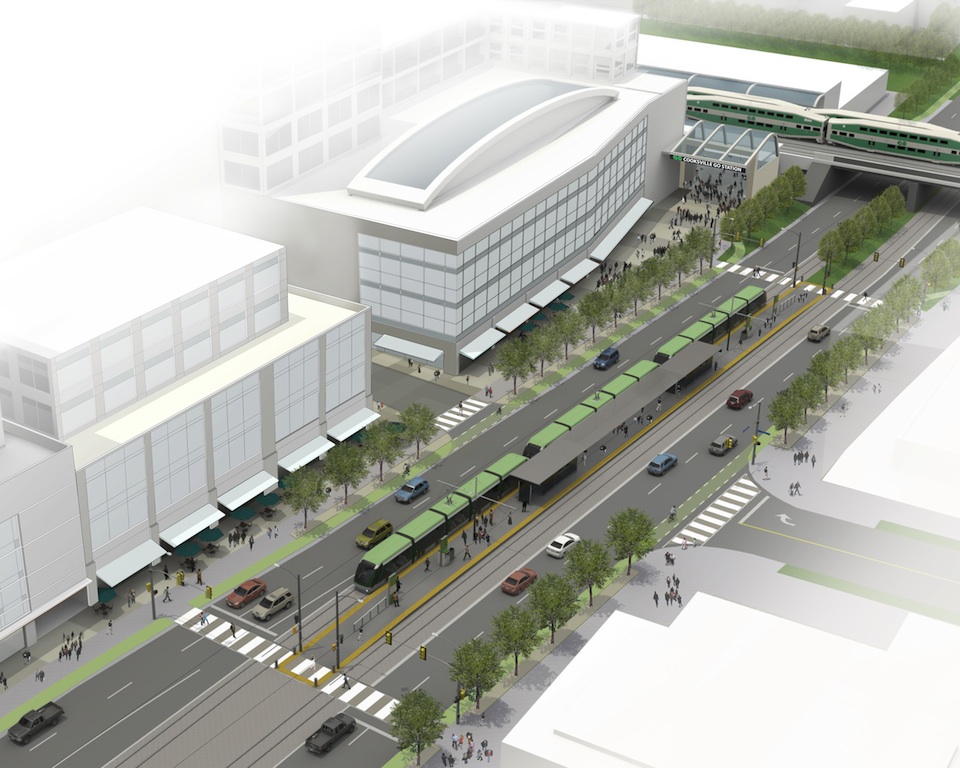




In the case of the LRT line, the cost includes, the cost of the Light Rail Vehicles where Skytrain costs don’t.
The current cost of the Arbutus Millennium Line extension is $2.83 Billion.
The current cost of the SLS (Surrey to Langley Skytrain Expo Line extension) is $4.01 Billion.
The cost of OMC #5 (Operations and Maintenance Center), which needs to be opened before the SLS Line extension and is based on another separate contract, so its costs aren’t included as part of the SLS contract.The expected final cost of the OMC#5 is between $500 Million to $1 Billion.
Translink is spending $1.4 Billion for the new 5 section long (5 cars long) Skytrains trainsets (about $747 Million for 41, 5 section trainsets or 205 cars total) and another $ 650 Million to $700 Million for the new ATC (Automatic Train Control hardware and software). The new trainsets are desperately needed to replace the old Mk.1 Skytrain cars and provide operating trainsets for the SLS extension. The old ATC system and software is no longer supported by its maker, so a new one will be needed as well.
There is still roughly another $1.6 Billion needed for physical track, power system and structural upgrades to the 19 km to 20 km long, above grade original section of the 37+ year old Expo Line that hasn’t been budgeted for yet.
That’s between $ 8.74 Billion to $9.24 Billion for 21.7 km of Light Metro or $406 Million to $429 Million per km for everything needed to open both extensions. This doesn’t include the missing $1.6 Billion yet to be budgeted for more Expo and Millennium Line upgrades.
The 18 km Hazel McCallian surface LRT Line (formerely the Hurontario LRT Line) with everything included is $1.4 Billion or $77.778 Million per km. The line is designed so that the initial 4 section LRV trainsets (48m long) can be expanded to the 2 car LRV trainsets (96.5m long) assuming they are using the Alstom Citadis LRV’s, without having to physically upgrade the station platforms, which are 90 to 95m long.
The end to end travel time is 22% – 25% slower for a physically segregated surface LRT line compared to a grade separated and physically segregated Light Metro Line. However, it’s not that much slower when you consider that, this north-south LRT line crosses 2 GO Train lines, both of which are being upgraded to full regional railway lines with 15 and 30 minute peak hour service and 15 minute and one hour off peak service, all day, every day in both directions and an existing heavy BRT Busway (known as the Mississauga Transitway) which is physically similar to Ottawa’s Bus Transitways. So very few passengers on this LRT line are traveling the full distance end to end and thus won’t suffer significant time penalties.
Unfortunately, the cost-benefit Ratio used to justify the Skytrain over 2 LRT lines in Surrey (for less money by the way) didn’t generally consider the superiority of the network effect the 2 planned LRT line had compared to the very expensive end of line extension of the SLS project. The original 2 LRT lines both operating through central Surrey, had a clear operating advantages over potentially, 2 Skytrain lines meeting in central Surrey (due to the planned Skytrain branch to White Rock). Unfortunately, the fact that the current Expo Line is operating at its maximum capacity and in that situation, it’s never good to add any future branch lines, especially when you are already on a branch line. Potentially, many LRT lines could have easily fed into the central Surrey LRT tracks. Yes, there would be a transfer to get to the Skytrain but there would be a much greater passenger carrying capacity in Surrey for Surrey and Langley bound local destinations.
The original Hurontario LRT Line length was 22 km because the Mississauga City Centre loop and the northerly, final 2 to 3 km were cut for political reasons (a provincial Liberal project and a very Conservative city council) and would have ended at a 3rd GO Train Line, this one on the very busy Georgetown Corridor in downtown Brampton. Ironically, even wIth a more politically conservative City of Brampton coucil, Brampton politicians are now desperate to find a way to connect this line back to Brampton station due to the massive political fallout from the former council’s decision, to back out of the original project.
To make these Skytrain line extensions operational, Translink will spend 5.2 to 5.5 times the cost/km of this surface LRT line in Ontario. If you are spending over 5 times as much to get a 22% – 25% end to end speed advantage, a rethink for future Skytrain lines is definitely needed. Even at just 3 times the cost/km compared to a mostly grade and physically segregated LRT line (3.7 times the per km cost of Ottawa’s Stage 2 LRT Project), would be enough for me to force a rethink about where and when a Skytrain Light Metro Line is more appropriate. Especially, when the 18 km Hazel McCallian LRT Line is expected to carry between 35,000 and 65,000 passengers a day upon opening in late 2024 or early 2025, compared to the 56,000 passengers a day the 16 km SLS extension will get in 2028.
Just a note. I have heard from two different sources that there is going to be some very unpleasant news regarding both the Broadway subway and the Expo Line extension to Langley. This news will be released on a Friday, a few weeks after the civic elections. The only reason I know this, as I was phoned by two different people, working on two different election campaigns to see if I knew anything. My guess is a new and higher cost for both due to inflation.
I included inflation in the post by using the Bank of Canada inflation calculator and a applied to the 2018 cost.
Also, is the slower travel times for LRT the result of more stations? More stations = easier access.
The slower speed is mainly due to having to cross a significant number of signaled intersections at grade over 18 km of route. However, like I said before, considering the fact that very few riders are going to be traveling the entire length of the line end to end it won’t mean that much real extra time. There are so many rapid transit lines, job centres, shopping facilities, recreational and entertainment locations along Hurontario Street that these LRV’s could have each of their seats or standing spaces potentially used by 3 or 4 people over the routes entire length. That’s why the passenger estimate for opening day is such a wide estimate, ranging from the pessimistic to the unbelievable positive.
Fun fact, I just recently found out some interesting transit data about the stretch of Hurontario Street between downtown Brampton and downtown Mississauga (The Mississauga City Centre Area). At peak periods, before Covid 19, that roughly 12 km long part of Hurontario Street was serviced by both Myway (Mississauga Transit) both express (Orange Routes) and local routes (Blue Routes) as well as Brampton Transit’s “Zuum express BRT routes” (Brampton’s very very successful “BRT Lite” network).
At peak, there were 40 to 50 buses per hour per direction operating daily along this part of the Hurontario Street transit corridor. The road is mostly 6 lanes wide, some minor parts wider (7 to 8 lanes) others slightly more narrow (5 lanes). It is quite an interesting comparison to Broadway in Vancouver.
Although considerably less dense outside of the Mississauga City Centre, being built up in the 3 decades between the 60’s through to the early 90’s as well as lacking a University but having 2 separate cities with 2 separate downtowns along its length (Brampton’s downtown being very small and in need of economic regeneration), multiple large shopping malls and significant recreational sites, 2 OHL arenas (for the Mississauga Ice Dogs and the Brampton Battalion) with seating capacities of over 3000 seats each.
Zwei, I would have thought that the prices for the Surrey Langley Skytrain were more or less set but as I just looked it up, they aren’t in the Request for Proposal Stage but they are still in the Request for Qualifications Stage so, it’s very possible prices could still go up. The RFQ stage isn’t expected to be completed until November 1, 2022. Just looked on the B.C. government website the $4.01 Billion contract for the line itself is broken up into 3 subcontracts, which is becoming quite common. The assumption is that three smaller contracts should be better and easier to manage than one big contract.
1. The elevated concrete right of way
2. The stations, including active transportation elements, such as cycling and walking paths around the stations.
3. The design and installation of SkyTrain trackwork, as well as the design, installation and integration of electrical systems, such as power, telecommunications and automatic train control.
Still no mention of the contract for OMC#5? I looked at the 2022 Translink Investment Plan (written in late 2021) it still has the cost of OMC 5 as $530 Million however that was before the war started in Ukraine and inflation really started to take off, so who knows, that estimate might be so heavily padded that they might be ok?
What were those campaign people hinting at?
Zwei replies: What I have been told by two very different people is that some very bad news will be released after the civic elections about both projects.
The big issue is housing but it seems every one is on the wrong track with that one. The following is from Patrick Condon, James Taylor chair in Landscape and Livable Environments at the University of British Columbia’s School of Architecture and Landscape Architecture.
After all, Vancouver has, since the 1980s, added more new housing units
per capita than any other centre city in North America. It’s called
Vancouverism and the downtown is the internationally recognized emblem
for this strategy. If simply adding new units would bring housing
prices down, Vancouver should have North America’s cheapest housing.
Instead it has North America’s most expensive housing, by far (when
measured by the gap between market rates and average household incomes).
The transit issue is simply build more Skytrain, but almost no one is talking about cost.
We all know road pricing is on the table, but with current economic issues, there will be mass protests if Metro mayors implement this.
Nothing shocks me any more with transit, as it seems the entire planning process has been bought off.
Did you know that many local politicos do not realize that Alstom owns the damn thing now and they are the sole supplier.
I believe the NDP are in somewhat serious trouble and the coronation of David Eby may add to their woes. I call him Vision Vancouver’s candidate for premier.
Our province wide Civic elections are to be held on October 24, 2022, when is the election in B.C.?
Zwei replies: I believe our civic elections are on oct. 15.
One of the most dubious but least talked about issues when trying to plan, design and construct any majorl rapid transit project or line extension, is the time spent during the “political part”, usually the planning, approval (including the funding debates) and design process. Unless there is a crystal clear vision by everyone involved from the beginning, the debate can last years, throw in multiple municipal elections and more debate/time is added. I’m not saying the public shouldn’t be involved but wow, excess public involvement can make a straight forward project very complex and time consuming.
The debate, political angst, cancelling, project scope change, re-planning, neo-debate, secondary debate, political debate due to buyers remorse and finally acceptance leading to the actual start of pre construction around what would eventually be the Confederation LRT Line here in Ottawa, was a 12 year long, gut wrenching political drama (roughly 2002-2014). Much of this extra time was caused in my opinion, by way too much public involvement trying to rehash everybody of the project. This added real cost through multiple project scope changes and natural inflation. What was originally a $800 Million to $1 Billion project, mostly running on the surface, turned into a shorter line with a downtown tunnel for $2.13 Billion, the 2.5 km tunnel (and its 3 stations) was over 1/3 of the entire project’s budget.
Years later, around 2017, I had an enlightening conversation with one of the project’s biggest public detractors. He admitted that, he understood that stopping any project like this is easier if you keep the debate going around the project. Even after the start of construction, any minor construction issue was blown up to near biblical proportions. I have to admit, it was very very effective.
I asked him what was it about the project he so hated. It was simply that, “with your generation and younger now in charge (I’m Gen X, he is obviously a Boomer), we may never build another major road/expressway project in Ottawa ever again. Everyone will want their LRT extension to their part of Ottawa, built first, sucking up nearly all of the local, provincial and federal funding for infrastructure. I won’t see another highway built in my lifetime”.
To make a long story short, he didn’t care about the efficiency of LRT or any rapid transit technologies in moving more people than roads, transit’s inherent land use advantages or the environment. His simple point was he didn’t care, “I prefer driving, I will never use transit, I’m an elite and your not”, essentially saying he’s a higher class of human than anyone on transit and his concerns should ALWAYS come first before anyone else’s, especially those on transit. Unfortunately, it has been my experience that this opinion by so called “road-warriors” is pretty common behind closed doors, its rarely seen in public, for obvious reasons.
The moral of the story, dragging out the anti-debate on any infrastructure project, will on average, eventually lead to its cancellation. So if you want, to build ,build fast because drawn out debate will eventuallly kill or majorally delay all projects. This is one of the reasons that the Skytrain extension to Langley (even if it is built) will most likely end up killing off future Skytrain extensions. Good or bad, the extension to UBC will most likely occur however, beyond that, Skytrain’s, sky high cost, especially when you consider what it actually does and how little you get for that cost, as well as Skytrain’s other major technological, operational and design disadvantages, will pretty much doom any other extension to the network. Case in point, Translink’s sudden iinterest in planning true or real BRT throughout its service area (not the rapid bus express bus routes it’s been building).